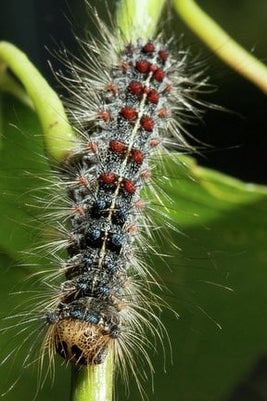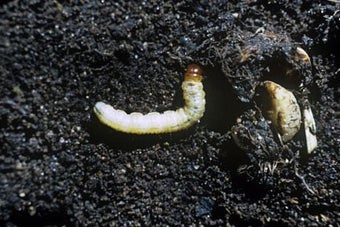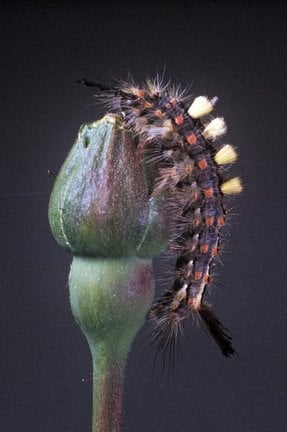
Quick facts
Common name - Spongy moth (formerly known as Gypsy moth)
Scientific name - Lymantria dispar
Plants affected - A wide variety of trees and shrubs
Main symptoms - Large (up to 7 cm long) brownish yellow, hairy caterpillars
Most active - April to August
What is spongy moth?
Spongy moth, formerly known as the gypsy moth, has caterpillars that can defoliate trees and shrubs. The European strain of this moth has become established in London and surrounds. The adults are sexually dimorphic (have different appearances); males have a wingspan of 3.5-4 cm and are greyish brown, females have a wingspan of 4.5-6 cm and are white with a few darker markings.
It is the caterpillars that are often noticed in gardens as they are up to 7 cm long and have yellowish heads with hairy brownish yellow and black bodies. There are a series of 5 pairs of blue spots and 6 pairs of red spots along the body. Numbers of caterpillars can reach high densities and trees and shrubs can be stripped of foliage.

Symptoms
Large (up to 7 cm long) brownish yellow and black hairy caterpillars, with red and blue markings causing defoliation of large parts of a wide variety of trees or shrubs.
Spongy moth should not be confused with oak processionary moth, which has dark coloured caterpillars with fine white hairs and is only found on oak. Hairs from the spongy moth do not usually cause irritation but those from oak processionary moth often do.
The caterpillars of spongy moth are present from April to August and when fully grown pupate on a surface such as the of a tree, brick wall or other vertical surface. The pupal stage lasts about two weeks and emerging adult moths are active from July to September. Eggs are laid in clusters of 50-800 on the bark of host plants. These clusters are covered in hairs and measure up to 4 cm in diameter; the eggs hatch the following spring.
The moth is most prevalent in London and a few surrounding areas. More infomation can be found from Forest Research.
Management
- Where possible tolerate populations of caterpillars, as butterflies and moths are an important part of the garden ecosystem. Encourage predators and other natural enemies in the garden such as birds, wasps and ground beetles
- Check plants regularly from April for the presence of larvae and remove by hand where practical. Although the hairs are not known to be irritant wearing gloves should be considered
Biology
The British strain of spongy moth which fed on bog-myrtle (Myrica gale) and creeping willow (Salix repens) went extinct in the early 1900s. However, the European form of the insect became established in London during the 1990s. It can feed on a wide variety of trees and shrubs. Large numbers of the caterpillars cause significant defoliation and in North America, where it is also a non-native, the moth can be a serious problem in woodlands and forests.
Adult moths emerge from pupae during the summer months. Females release a sex pheromone which attracts the males. Eggs are laid in clusters of up to 800 under a layer of hairs. The eggs hatch in spring. Hatchling larvae are 2 mm long hairy and dark, as they grow they remain hairy becoming brownish yellow with red and blue markings, the head is a dirty yellow colour. The caterpillars can reach 7 cm long before finding a place to pupate in mid to late summer. The pupae are anchored to vertical surfaces such as tree and walls. After two weeks adult moths emerge.






